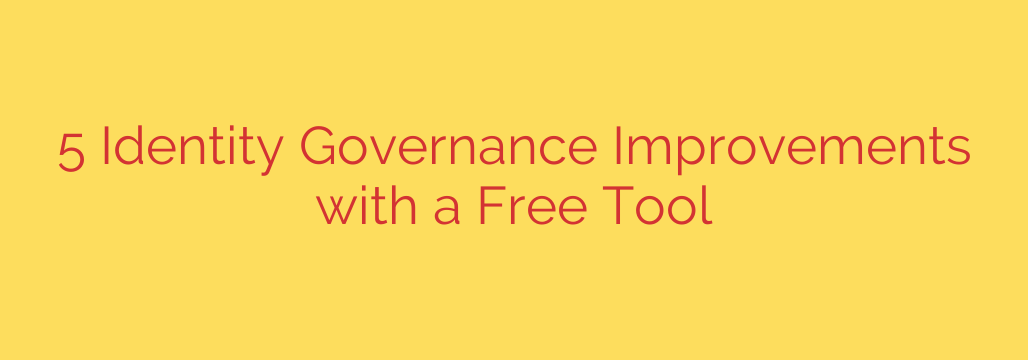
Strengthen Your Security: 5 Ways to Master Identity Governance and Administration
In today’s sprawling digital workplace, managing user access is more than just an IT chore—it’s a critical security function. Answering the simple question, “Who has access to what?” can be a surprisingly difficult and time-consuming task. Without a clear strategy for Identity Governance and Administration (IGA), organizations expose themselves to significant risks, including data breaches, compliance failures, and operational chaos.
Effective IGA ensures that the right individuals have the right access to the right resources at the right times, and for the right reasons. Moving away from manual, spreadsheet-based tracking is the first step toward building a secure and efficient system. Here are five essential improvements you can make to strengthen your organization’s identity governance framework.
1. Gain Crystal-Clear Visibility into All User Access
The foundation of strong security is visibility. If you don’t have a clear, centralized view of all user permissions across your applications and systems, you’re essentially flying blind. Relying on disconnected spreadsheets or native admin consoles for each app creates information silos that make it impossible to get a complete picture.
A robust IGA approach consolidates this information into a single dashboard. This provides a centralized source of truth for all user entitlements, allowing you to instantly see who has access to sensitive data, whether they are an employee, contractor, or third-party vendor. This comprehensive visibility is the first step in identifying and mitigating potential risks before they become major security incidents.
2. Eliminate “Privilege Creep” with Regular Access Reviews
Over time, employees naturally accumulate access rights as they change roles, join new projects, or take on temporary responsibilities. The problem is, this access is rarely revoked when it’s no longer needed. This phenomenon, known as privilege creep, creates a massive security vulnerability by leaving users with excessive permissions.
To combat this, you must implement periodic access reviews, or “attestation campaigns.” During these reviews, managers or application owners are required to certify whether their team members still need their current levels of access. This process systematically enforces the principle of least privilege, ensuring users only have the permissions essential for their jobs. Automating reminders and tracking for these reviews transforms a manual, error-prone task into a streamlined and effective security control.
3. Streamline Onboarding and Offboarding Processes
Manual onboarding and offboarding processes are not only inefficient but also incredibly risky. A new hire might wait days for the access they need to be productive, while a departing employee’s accounts might remain active long after they’ve left, creating a significant security hole.
A structured IGA system helps standardize these critical workflows. For onboarding, you can create role-based access templates to grant day-one access to all necessary systems automatically. More importantly, for offboarding, you can ensure that all access rights are immediately and completely deprovisioned the moment an employee leaves. This removes the risk of orphaned accounts and prevents disgruntled ex-employees from retaining access to sensitive company data.
4. Simplify Compliance and Ace Your Next Audit
For organizations subject to regulations like SOX, GDPR, or HIPAA, proving compliance is a non-negotiable requirement. Auditors will demand detailed evidence of who has access to sensitive financial or personal data and how that access is being managed and reviewed. Manually gathering this information from dozens of different systems can take weeks of painstaking work.
Modern governance tools can generate comprehensive, audit-ready reports with just a few clicks. By having a historical record of all access requests, approvals, reviews, and revocations in one place, you can confidently demonstrate compliance to auditors and internal stakeholders. This not only saves an immense amount of time and resources but also reduces the risk of costly compliance penalties.
5. Identify and Remove Risky Orphaned Accounts
Orphaned accounts—user accounts that are still active but are no longer associated with a current employee—are like unlocked backdoors into your network. They are often forgotten by IT teams and are a prime target for attackers looking for an easy way to gain a foothold in your systems. These accounts can result from improper offboarding, project decommissions, or system migrations.
By reconciling user lists from your HR system with the active accounts in your applications, a proper governance solution can quickly identify and flag these high-risk orphaned accounts. This allows your security team to investigate and deprovision them promptly, closing dangerous and unmonitored access points before they can be exploited.
Taking control of your identity governance is no longer optional. It is a fundamental strategy for reducing risk, improving operational efficiency, and building a stronger, more resilient security posture.
Source: https://www.bleepingcomputer.com/news/security/5-ways-to-streamline-identity-governance-with-this-free-tool/








